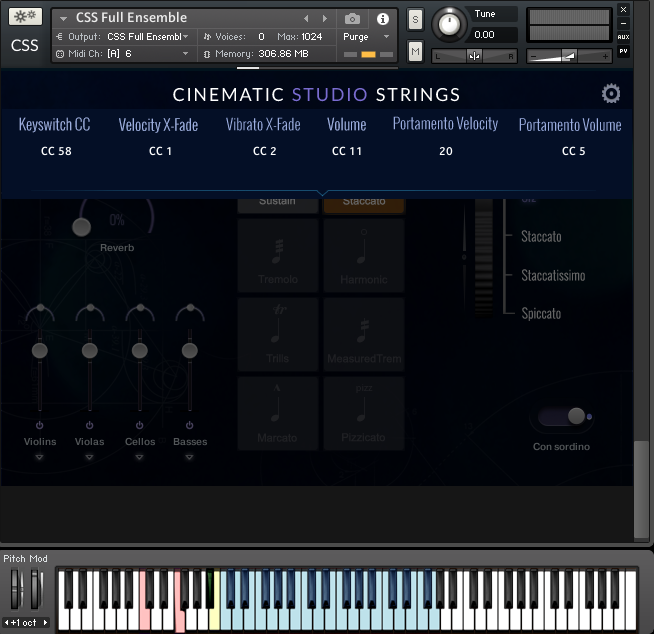
Cinematic Studio Strings:
A Sample Library Review
Review by: Andrew Overfield
Developer: Cinematic Strings
Composer: Andrew Overfield
Sound Designer: Alex Wallbank
Reviewed on: MacBook Pro 16GB DDR3 2.2GHz i7
Cinematic Studio Strings is the latest release from Cinematic Samples’ roster of hard-hitting and well-respected sample libraries.
The Sound Architect are privileged to be able to bring to you a review of the library and include a video review to compliment this.
I must admit, prior to receiving my copy to review, my hand was already in my pocket, eager to try out what the team had in store. So the opportunity to review the library came and I jumped at the chance.
Now this article will be much shorter than my previous article as the bulk of the content will be in the video review provided but I will cover a few points for those of you just want a quick overview of the library whilst on the go.
Setup & Interface
The library is very easy to setup and get going. It is however a hungry library in terms of RAM. I would recommend on a small-ish system, making sure you’re loading multiple patches in one instance of Kontakt to preserve CPU and RAM usage. I would also recommend purging any of the samples in the patches you are not using to limit the amount of resources being used up at any one time. You can easily do this by ALT+clicking the desired articulation to turn it off.
The interface is clean and well planned. You can easily identify the settings from con sordino and true legato and modify virtually all of the keyswitches by holding down SHIFT when selecting the correct parameter.
This makes it very useful for players to customise their own patch to suit their playstyle and type of MIDI keyboard being used. It is very fluent in it’s transitions from articulation to articulation and ideal in situations where composers prefer to play their compositions in live and make small tweaks afterwards.
I, unfortunately am not one of those composer. I prefer to draw my midi data in manually and edit as I go to make sure notes and articulations are precise. Which made it a little annoy when having to switch between articulations and draw in the keyswitches, but nothing to overly complain about.
Sound
The library sounds amazing. As I previously said I was on the tipping point of buying this anyway due to the brilliant reviews I had seen beforehand and after hearing it’s lush production I wanted in.
 For me it took some time to get used to changing velocities to determine the speed of the legato notes but once you get the hang of it, the seamless transition between notes gives a very intimate and somewhat “breathy” sound to the strings.
For me it took some time to get used to changing velocities to determine the speed of the legato notes but once you get the hang of it, the seamless transition between notes gives a very intimate and somewhat “breathy” sound to the strings.
In terms of the rest of the articulations, the tremolo strings don’t sound as muddy as what I’ve experienced in the past and the trills and harmonics give opportunities to expand on your own palette. I’ve already been sampling some of the sounds to come up with some crazy horror sound design.
The marcato patch compensates for the lack of bite in the legato lines by adding a singular staccato note to overlay each marcato hit to accentuate the line. You can also turn this off if you prefer which is handy.
Now I’m very used to libraries with a lot of bite, which based on my own compositional style works very well for me. There’s an amount of that missing in the library but once I overlayed it with some other string sections it sounded powerful yet precise. I’ll definitely be using much, much more of CSS in my future compositions.
I’ve actually used this one a more intimate piece for a pitch I’m currently working on and it takes away a lot of my post-production I have to do with a lot of my other string libraries which saves me a lot of time and hassle. It has been recorded and well produced to give you a great out of the box sound.
I would recommend playing with the mic positions, you get a great “airy” type sound when you have room and main mics on however, play with at your content to find the right dryness of the mix you want.
Overall
CSS is a good tool for most composers to add to their current arsenal of string libraries to add some more depth to their compositions. There’s a certain flavour of sound it offers which I currently don’t own and can make a lot of use out of.
Support is fantastic. A couple of questions on some issues I was having and Alex Wallbank was straight back to me with some quick-fire answers that resolved my queries. I would recommend having a good read through the manual to double check your keyswitch activations and velocities required for them.
At a price tag of $399 it sits in a very good price range compared to many other string libraries and offers a more affordable, yet professional alternative to others on the market.
What I would also recommend is checking out in the link below the direct link to the website where Alex delivers some great tutorials and brilliant insights into the articulations and the technical demonstrations of the library and exactly what it can offer. There are some great examples of how well this library can be used.
And what makes it even better, the demonstrations also have downloadable MIDI files you can put directly into your DAW to see how it works for yourself!
I must admit I’m very impressed with the time and effort that has gone into CSS and with the recent trends of solid support being offered these days, it only makes sense that such great content is coming from the Cinematic Strings team.
Have a watch of the embedded video and let us know what you think!
Until next time….
LINKS
Official
Cinematic Studio Strings
Cinematic Strings Soundcloud
Cinematic Strings
We hope you enjoyed Andrew’s review, check out others in our Reviews section. Don’t forget to sign up to our Monthly Newsletter to make sure you don’t miss out on our reviews and interviews.
We’re also running a Patreon campaign to make sure we can keep bringing you regular, high quality content if you’re feeling generous! Thanks for sharing!
The Sound Architect





